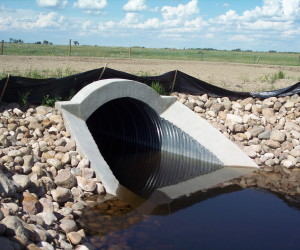The hydraulic diameter is a term used in fluid mechanics and thermodynamics. It is a measure of the efficiency of a section to pass flow by relating the cross-sectional area of flow to the wetted perimeter of the cross-section.
The hydraulic diameter of a round pipe is simply its diameter. The equations for hydraulic diameter for other cross-sections are given in the table below.
| Flowing Full | |
|---|---|
| Circle | $latex D$ |
| Annulus | $latex D_{outside} – D_{inside}$ |
| Square (L = side) | $latex L$ |
| Rectangle (L1 and L2 = sides) | $latex \frac{2L_1L_2}{L_1 + L_2}&s=1$ |
| Flowing partially full | |
| Half-filled circle (d = diameter) | $latex d&s=1$ |
| Rectangle (h = height, w = width) | $latex \frac{4hw}{w + 2h}&s=2$ |
| Wide, shallow stream (d = depth) | $latex 4d&s=1$ |
| Triangle (d = depth, t = top, s = side length) | $latex \frac{d\cdot t}{s}&s=2$ |
| Trapezoid (d = depth, t = top, b = bottom, s = side length) | $latex \frac{2d(t + b)}{b + 2s}&s=2$ |
The hydraulic diameter should not to be confused with the hydraulic radius term in the Manning equation, which is not half of the hydraulic diameter, but rather one quarter.

Speak Your Mind